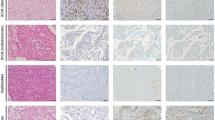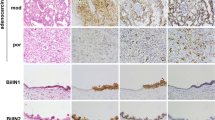Abstract
Background
Because the biopsy specimen of extrahepatic bile duct carcinoma (EHBDC) is small and shows reactive changes, the histological distinction between malignant and benign tissue can be difficult. Recent studies reported that S100P and insulin-like growth factor II mRNA-binding protein 3 (IMP3) were not only diagnostic molecules but also prognostic biomarkers in several organs. The objective of this study is to clarify the diagnostic and prognostic value of immunohistochemical expression of S100P and IMP3 in transpapillary biliary forceps biopsy (TBFB) samples.
Methods
The TBFB samples were collected from 80 patients (EHBDC, 68 patients; benign, 12 patients), retrospectively.
Results
When using cytoplasmic-positive staining for IMP3 as a marker of malignancy, the sensitivity and specificity reached 79.4 and 91.7 %, respectively. The sensitivity, specificity and accuracy achieved 89.7, 91.7 and 90.0 %, respectively, when using positive staining for IMP3 and/or positive histology as a maker of malignancy. While univariate (P = 0.033) and multivariate (P = 0.039) analysis revealed that S100P-positive EHBDC patients showed significantly shorter survival.
Conclusions
The results of this study suggest that immunohistochemical staining for IMP3 is useful in the diagnosis of EHBDC and that of S100P is useful as a prognostic marker for EHBDC.

Similar content being viewed by others
References
Ebata T, Yokoyama Y, Igami T, Sugawara G, Takahashi Y, Nimura Y, et al. Hepatopancreatoduodenectomy for cholangiocarcinoma: a single-center review of 85 consecutive patients. Ann Surg. 2012;256:297–305.
Nagino M, Kamiya J, Nishio H, Ebata T, Arai T, Nimura Y. Two hundred forty consecutive portal vein embolizations before extended hepatectomy for biliary cancer surgical outcome and long-term follow-up. Ann Surg. 2006;243:364–72.
Nagino M, Nimura Y, Nishio H, Ebata T, Igami T, Matsushita M, et al. Hepatectomy with simultaneous resection of the portal vein and hepatic artery for advanced perihilar cholangiocarcinoma. Ann Surg. 2010;252:115–23.
Natsume S, Ebata T, Yokoyama Y, Igami T, Sugawara G, Shimoyama Y, et al. Clinical significance of left trisectionectomy for perihilar cholangiocarcinoma: an appraisal and complication with left hepatectomy. Ann Surg. 2012;255:754–62.
Kawashima H, Itoh A, Ohno E, Goto H, Hirooka Y. Transpapillary biliary forceps biopsy to distinguish benign biliary stricture from malignancy: how many tissue samples should be obtained? Dig Endosc. 2012;24:s22–7.
Sugiyama M, Atomi T, Wada N, Kuroda A, Muto T. Endoscopic transpapillary bile duct biopsy without sphincterotomy for diagnosis biliary strictures: a prospective comparative study with bile brush cytology. Am J Gastroenterol. 1996;91:465–7.
Tamada K, Tomiyama T, Wada S, Ohashi A, Satoh Y, Ido K, et al. Endoscopic transpapillary bile duct biopsy with the combination of intraductal ultrasonography in the diagnosis of biliary strictures. Gut. 2002;50:326–31.
De Bellis M, Sherman S, Fogel EL, Cramer H, Chappo J, McHenry L Jr, et al. Tissue sampling at ERCP in suspected malignant biliary strictures (Part 1). Gastrointest Endosc. 2002;56:552–61.
De Bellis M, Sherman S, Fogel EL, Cramer H, Chappo J, McHenry L Jr, et al. Tissue sampling at ERCP in suspected malignant biliary strictures (Part 2). Gastrointest Endosc. 2002;56:720–30.
Becker T, Gerke V, Kube E, Weber K. S100P, a novel Ca(2+)-binding protein from human placenta. cDNA cloning, recombinant protein expression and Ca2+ binding properties. Eur J Biochem. 1992;207:541–7.
Nielsen J, Christiansen J, Lykke-Andersen J, Johnsen AH, Wewer UM, Nielsen FC. A family of insulin-like growth factor II mRNA-binding proteins represses translation in late development. Mol Cell Biol. 1999;19:1262–70.
Aishima S, Fujita N, Mano Y, Kubo Y, Tanaka Y, Taketomi A. Different roles of S100P overexpression in intrahepatic cholangiocarcinoma: carcinogenesis of perihilar type and aggressive behavior of peripheral type. Am J Surg Pathol. 2011;35:590–8.
Hamada S, Satoh K, Hirota M, Kanno A, Ishida K, Umino J, et al. Calcium-binding protein S100P is a novel diagnostic marker of cholangiocarcinoma. Cancer Sci. 2011;102:150–6.
Levy M, Lin F, Xu H, Dhall D, Spaulding BO, Wang HL. S100P, von Hipple-Lindau gene product, and IMP3 serve as a useful immunohistochemical panel in the diagnosis of adenocarcinoma on endoscopic bile duct biopsy. Hum Pathol. 2010;41:1210–9.
Reiner MO, Frizsche FR, Clavien PA, Pestalozzi BC, Probst-Hensch N, Jochum W. IMP3 expression in lesions of the biliary tract: a marker for high-grade dysplasia and an independent prognostic factor in bile duct carcinomas. Hum Pathol. 2009;40:1377–87.
Dowen SE, Crnogorac-Jurcevic T, Gangeswaran R, Hansen M, Eloranta JJ, Bhakta V, et al. Expression of S100P and its novel binding partner S100PBPR in early pancreatic cancer. Am J Pathol. 2005;166:81–92.
Hashimoto K, Yamamoto H, Shiratsuchi H, Nakashima T, Tamiya S, Higaki Y, et al. S100P expression in ductal type of carcinoma ex pleomorphic adenoma. Am J Surg Pathol. 2011;35:346–55.
Li C, Rock KL, Woda BA, Jiang Z, Fraire AE, Dresser K. Expression of a novel biomarker for adenocarcinoma in situ of the uterine cervix: an immunohistochemical study in comparison with p16(INK4a) expression. Mod Pathol. 2007;20:242–7.
Lin F, Shi J, Liu H, Hull ME, Dupree W, Prichard JW, et al. Diagnostic utility of S100P and von Hippel-Lindau gene product (pVHL) in pancreatic adenocarcinoma-with implication of their roles in early tumorigenesis. Am J Surg Pathol. 2008;32:78–91.
Pryor JG, Bourne PA, Yang Q, Spaulding BO, Scott GA, Xu H. IMP-3 is a novel progression marker in malignant melanoma. Mod Pathol. 2008;21:431–7.
Yantiss RK, Woda BA, Fanger GR, Kalos M, Whalen GF, Tada H, et al. KOC (K homology domain containing protein overexpressed in cancer): a novel molecular marker that distinguishes between benign and malignant lesions of the pancreas. Am J Surg Pathol. 2005;29:188–95.
Kawashima H, Itoh A, Ohno E, Itoh Y, Ebata T, Nagino M, et al. Preoperative endoscopic nasobiliary drainage in 164 consecutive patients with suspected perihilar cholangiocarcinoma—a retrospective study of efficacy and risk factors related to complications. Ann Surg (in press).
Edge SB, Byrd DR, Compton CC, Fritz AG, Greene FL, Trotti A 3rd. AJCC cancer staging manual. 7th ed. Berlin: Springer; 2010.
Sakamoto E, Nimura Y, Hayakawa N, Kamiya J, Kondo S, Nagino M, et al. The pattern of infiltration at the proximal border of hilar bile duct carcinoma. A histologic analysis of 62 resected cases. Ann Surg. 1998;227:405–11.
Bosman FT, Carneiro F, Hruban RH, Theise ND. WHO classification of tumours of the digestive system. Lyon: IARC; 2010.
Takahashi Y, Nagino M, Nishio H, Ebata T, Igami T, Nimura Y. Percutaneous transhepatic biliary drainage catheter tract recurrence in cholangiocarcinoma. Br J Surg. 2010;97:1860–6.
Acknowledgments
This work was supported by Grant-in Aid for Young Scientists (B) 22790525 from the Ministry of Education, Culture, Sports, Science and Technology of Japan. Additionally, the authors wish to thank Yuya Itoh, MD, Yosuke Nakamura, MD, Takeshi Hiramatsu, MD, Hiroyuki Sugimoto, MD, Hajime Sumi, MD and Daijuro Hayashi, MD for their contributions.
Author information
Authors and Affiliations
Corresponding author
About this article
Cite this article
Kawashima, H., Itoh, A., Ohno, E. et al. Diagnostic and prognostic value of immunohistochemical expression of S100P and IMP3 in transpapillary biliary forceps biopsy samples of extrahepatic bile duct carcinoma. J Hepatobiliary Pancreat Sci 20, 441–447 (2013). https://doi.org/10.1007/s00534-012-0581-z
Published:
Issue Date:
DOI: https://doi.org/10.1007/s00534-012-0581-z




